Pelee Island Vineyards
Pelee Island Vineyards
The Island has a unique microclimate that is ideal for growing grapes.
SOIL
The land in the centre of the island is below lake level and is recovered land. Pelee Island once was a corral reef. As a result, the soils are shallow glacial and lake deposits, limestone base covered by Brookston clay.
Though not always the best soil for all crops, it is ideal for grape vines as it is well drained and less fertile. This allows for the vines' roots to dig deep in search of water which in turn allows for the roots to more efficiently pull out the nutrients and minerals from the soil to feed the fruit. This adds a special complexity and accentuating quality to the finished wine.
SUN/HEAT
Pelee Island gets a lot of sun in the summer, which is needed for the ripening period of the growing season. Additionally, there is the "lake effect" which allows the vineyard to enjoy more heat units than Bordeaux, France; Burgundy, France; and Mendocino County, California due to the tempering effect of Lake Erie which surrounds Pelee Island. The extended growing season of Canada's most southern inhabited island allows Pelee Island Winery grapes to reach their full potential and maturity.
With all these factors combined: soil, sun, climate and being situated along the southern latitude; contribute to create an internationally recognised viticultural region.
THE GROWING PROCESS
Once everything is set up, it takes approximately 2-4 years for the vines to produce good quality grapes for winemaking.
Pruning begins in March, assuring that the plant is focusing its energy into production the optimum number of grapes.
Bud burst begins to happen the first week of May, when leaves begin to grow along with tiny bunches that will eventually break open and flower. Springtime is the best for any new planting because the soil is still cool with some moisture which is important for young rootstock. Flowering fully takes effect early part of June and is perhaps the most critical stage, for ultimately, the number of flowers determines the number of bunches. Any frost or hail is extremely detrimental to the plants at this stage.
Small bunches of grapes are formed in late June, and the ripening process begins. Sunshine is extremely crucial during this ripening stage.
Harvests lasts from late August through mid-October and the whole grapes are shipped to the mainland by ferry.
Pelee Island Winery employs a proactive approach to maintaining and bettering the microclimate we are so fortunate to have. This preservation begins in the vineyards where Bruno Friesen, viticulturalist, uses a protocol for integrated pest management developed with support from World Wildlife Fund Canada (WWF).
Pelee Island Winery has a commitment to the limited use of ecologically responsible pesticide spraying and use of 'all natural' island-grown fertilizer (sorghum grass) are just two ways that Bruno has elevated the standard of Pelee Island Winery's vineyards above and beyond current regulations and guidelines.
For more on Pelee Island's Environmental Commitment click here.
Subscribe to:
Post Comments (Atom)






0 comments:
Post a Comment